Pull-up (exercise)
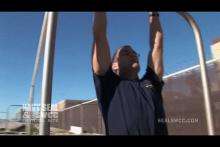
A pull-up is an upper-body compound pulling exercise. Although it can be performed with any grip, in recent years some have used the term to refer more specifically to a pull-up performed with a palms-forward position.
The term chin-up, traditionally referring to a pull-up with the chin brought over top of a bar, was used in the 1980s to refer to a palms-away (overhand/pronated) grip, with a palms-toward (underhand/supinated) grip being called a "reverse-grip" chin-up. [1][2][3][4]
In later decades, this usage has inverted, with some using "chin" to refer to a pull-up done with a palms-backward position. In spite of this, "chin" is still regularly used refer to overhand-grip.[5][6][7]
The most popular current meaning refers to a closed-chain bodyweight movement where the body is suspended by the arms, gripping something, and pulls up. As this happens, the wrists remain in neutral (straight, neither flexed nor extended) position, the elbows flex and the shoulder adducts and/or extends to bring the elbows to or sometimes behind the torso. The knees may be bent by choice or if the bar is not high enough. Bending the knees may reduce pendulum-type swinging.
A traditional pull-up relies on upper body strength with no swinging or "kipping" (using a forceful initial movement of the legs in order to gain momentum). The exercise mostly targets the latissimus dorsi muscle of the back along with other assisting muscles.
Earlier meanings
In past decades, a pull-up also included open-chain pulling exercises done with a barbell.[8] These exercises are now more popularly known as the bent-over row (in the 50s[8]) and upright row (in the 70s[9])
Etymology
The name refers to pulling up one's body. It can be done with the hands facing any directions, from prone to supine.
Some have associated a "pull-up" with utilizing an overhand (pronated; palms facing away) grip. This includes by the Boy Scouts of America,[10] Guinness World Records[11] "makes a difference between" pull-ups and chin-ups according to grip. Organizations such as the United States Marine Corps however, see pull-ups including both the overhand and underhand grips.[12]
A "chin up" is bringing the chin up to touch the bar or go over the bar, with a supinated palms-facing grip.
Variations of pull ups, beyond being named for their grip, can also be named based on how high the body rises, by naming it after the body part that either comes into contact with or passes over the top of the bar. A "chest-up" or "sternum-up" for example, indicates that the chest or sternum meets the bar, requiring extra scapular adduction and depression.
As a physical test
In armed forces
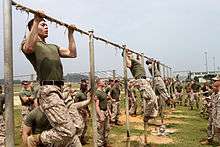
Pull ups are one of the best ways to measure the upper body strength of the "pulling muscles". They are used by the United States Marine Corps as a way to determine strength among service members. Untimed, 20 pull ups in a row is a perfect score in a physical condition test for the US military, while at least 3 must be done to earn any points.[13]
Pull ups was also used as part of military test in places such as Singapore, where the IPPT for National-Service men is used. It is also used in the NAPFA test for male students above the age of 14. It was then removed in 2014 with the announcement of a new IPPT format.[14]
Grips
Pull-ups (including chins) can be done with a supinated, neutral or pronated grip (often called "chin-ups", "hammer grip pull-ups", and "pull-ups", in order). Grips may match each other or be different (mixed grip). Grips may also rotate throughout the movement, such as by doing them on rings or rotating handles (false grip). The range of motion used by trainers can vary. The fullest possible range is with straight arms overhead (elbow directly above shoulder), to pulling when the arms are at the sides (elbow directly below shoulder). People sometimes only train portions, such as avoiding locking out the arms at the bottom, or stopping when the head/chin/neck touch the bar. Positions within the range are also trained isometrically, as in flexed-arm and straight-arm hangs for time.
The width of the grip may also differ. When grabbing and holding the bar during the pull-up, the hands can be apart at shoulder-width, or wider, or narrower enough to touch each other. This may make the pull-up more difficult and may limit the range of motion compared to the shoulder-width grip.
Muscles used
Trunk
Pull-ups primarily target the latissimus dorsi.
Arms
Pull-ups also work the brachialis and brachioradialis in the arms. These muscles are located near the elbow, and help move the forearm. The biceps brachii, or simply biceps, cross the elbow and shoulder joints and work to flex the elbow joint during the exercise. They are involved more with a supine grip.[15] The long head of the triceps also crosses the shoulder joint and assists in shoulder adduction.
Shoulders
Pull-ups use the teres major, a small muscle at the back of the shoulder blade. The nearby rhomboids,[16] which connect the spine to the shoulder blade, play a part too. Pull-ups also use the trapezius[16] along the spine and shoulder, and the levator scapulae[16] along the side of the neck. These muscles work to elevate and depress the shoulder blade, and are sometimes called the "shrugging muscles."
The deltoid muscles,[17] specifically the posterior deltoids[18] also assist.
Abdominal muscles
The abdominal muscles stabilize the torso by connecting the rib cage to the pelvis. The rectus abdominis (along with hip flexors) can generate force to lift the lower body up during kipping, but can also stabilize the front of the pelvis from drifting away from the sternum, just as the erector spinae help to keep the vertebrae from drifting apart in the back. The external and internal obliques perform similar roles on another plane, able to generate or prevent twisting or side-bending, and may help reduce body swinging. The transverse abdominis helps to prevent movement in all directions, encouraging a neutral position.
Pelvic floor
Pelvic floor muscles hold the organs up and stabilize the pelvis.[19]
Hands and forearms
The muscles of the forearm are also worked by holding the overall body weight, improving the strength of the fingers and the forearms muscles creating a strong isometric contraction in these muscle groups.
Safety
Organizations like the American Council on Exercise give advice such as "care should be taken not to unduly put stress on your shoulder during this exercise."[20] Elbow pain due to tendonitis, bursitis, and ulnar nerve entrapment can occur as a result of excessive pull ups and improper technique.
Variations
| Example | Type |
|---|---|
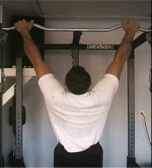 |
Standard Standard dead-hang pull up is grasped with an overhand/underhand/alternative-hand grip. Then the body is pulled up until the chin clears the bar, and finished by lowering the body until arms and shoulders are fully extended. Stricter standards would only consider a full repetition to be one in which the elbows pass behind the coronal plane. |
 |
Weighted Weight is added using a dipping belt, or grasping a dumbbell with the feet, or weight vest/shorts |
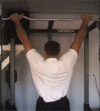 |
Behind-the-neck pull-up The chin is dropped forward through cervical flexion. The goal of the pull-up is to touch the bar with the back of the neck. |
|
Mixed grip One hand is placed in the overhand (pronated) position and the other is placed in the underhand (supinated) position to provide variation on the elbow flexors used. | |
|
Commando pullup Also called the cliffhanger pullup, the body is held sideways to the bar, hands right next to each other, one hand pronated and the other supinated, and the body is raised as far as possible (until one shoulder touches the bar). This variation emphasizes one arm, and can be used as a progression towards the one arm pullup. | |
 |
One arm A one arm pull-up is performed by grasping the bar with only one hand while pulling up. This is difficult due to the considerable strength required.[21] |
|
One hand An easier version of the one arm pull-up: a pull-up where one hand grips the other arm just below the wrist. | |
  |
Climber's chin-up A pull-up staying as close as possible to one side; typically the arm doing the majority of the work is alternated each repetition. In the most advanced version of this, one arm is kept totally straight; this is called the archer pullup. In an alternative version called the typewriter pullup or around the world pullup, the trainee comes up on one side, moves horizontally across to the other side while holding at the top, and then down on that side. |
|
Kipping An easier version in which the body is bent dynamically to help propel the athlete upward. The hips swing first forward and then back as the legs swing forward. Finally, the legs swing downward again, pushing the torso upward. The fastest version where the head follows an elliptical path, moving backward at the bottom of the motion and forward at the top, is sometimes called a butterfly pull-up.[22] | |
  |
Sternum chins A pull-up with a longer range of motion, finishing with the bar touching the sternum. |
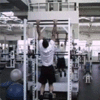 |
Muscle-up A pull-up with a maximal range of motion, transitioning to a dip. Generally the initial pull-up uses an overhand grip to make the switch easier and is more explosive in order to take advantage of momentum from the first half of the exercise to aid in the second half. |
|
Assisted Pull-Up A pull-up band is a large rubber band that is tied around the pull-up bar, then you place either a foot or a knee in the open "loop" hanging from the bar as you do your pull-ups. The band will assist you by taking on some of the bodyweight load and allowing your muscles to complete the pull up movement at a more manageable weight. | |
|
Sometimes called an "Australian pull-up", "reverse push-up", "inclined pull-up" or "inverted row", this is performed with the bar 2 to 3 feet off the floor. The trainee lies on the ground under the bar, face-up, and grasps the bar with extended arms. The exercise is performed by pulling the chest up to the bar. The body is held in a rigid plank position while the heels remain on the floor. "Supine" refers to the body being face-up, not to the grip: supine rows can be done with prone, neutral or supinated hands. |
World Records (pronated grip)
Guinness World Records
Bodyweight:
- Most in 60 seconds: 50 by Michael Eckert in Oct 2015.[23]
- Most in 1 hour: 1009 by Stephan Hyland in 2010.[24]
- Most in 6 hours: 3,515 by Andrew Shapiro in 2016[25]
- Most in 12 hours: 5,742 by Andrew Shapiro in 2016[26]
- Most in 24 hours: 7,306 and was achieved by Andrew Shapiro (USA).[27]
- Most in 24 hours(Female): 3,737 and was achieved by Eva Clarke (Australia) in 2016.[28]
Bodyweight (variations):
- Most Clap Pull-ups in one minute: 30 by Blake Augustine Dec 2015.[29] Video[30]
- Most one arm pull ups in one minute : 17 by George Gaydardzhiev 2012.
- Most consecutive pinky pull ups: 16 by Maibam Itomba Meitei (India) 2014.[31]
- Most consecutive muscle ups: 25 by Jarryd Rubinstein (Australia) 2010.[32]
Weighted:
- Most added weight: 230.49lbs by David Marchante in 2016.[33]
- Most in minute with 40 pounds: 29 by Ron Cooper and Adam Sandel in 2016.[34]
- Most in minute with 60 pounds: 23 by Ron Cooper in 2016.[35]
- Most in minute with 100 pounds: 14 by Steven Proto in 2014.[36]
RecordHolders.Org
As of January 2015 the most repetitions within a given time period:[37]
- 3 minutes: 100 by Ngo Xuan Chuyen (VIE) in 1988 during "Strongest Soldier in Vietnam" contest
- 30 minutes: 543 by Stephen Hyland (GBR) on 5 July 2010
- 24 hours: 4,654 by Jan Kareš (TCH) on 20 April 2014
alternativerecords.co.uk
- Heaviest weighted pull-up total: 402 lbs by Steven Proto (USA) on 28 April 2011[38]
- Most pull-ups with a 45 lb plate: 18 by Damien Longley (USA) on 28 March 2011[38][39]
See also
| Wikimedia Commons has media related to Pull-ups. |
References
- ↑ Darden, Ellington (14 November 1984). High-Intensity Bodybuilding. New York: The Putnam Publishing Group. pp. 151–153. ISBN 0-399-51103-2.
Behind neck chin up: .. Use an overhand grip.
- ↑ Boff, Vic (1985). "The Ever-Popular Chinning Bar". Vic Boff's Body Builder's Bible For Men and Women. New York: Arco Publishing, Inc. pp. 100–103. ISBN 0-668-05630-4.
Natural-Hands Grip: .. palms of your hands turned to the front .. Reverse-Hands Grip: .. palms of your hands facing your body .. The Neck Chin .. a wide natural-hands grip
(paper edition, ISBN changes to 0-668-05625-8 for cloth edition) - ↑ Kennedy, Robert; Greenwood-Robinson, Maggie (1987). "Wide Grip Chins". Built! The New Bodybuilding for Everyone!. New York: The Putnam Publishing Group. pp. 75–76. ISBN 0-399-51380-9.
Take a wide overhand grip on the chinning bar and slowly hoist your body up until your chin is just above the bar.
- ↑ Kennedy, Robert; Ross, Don (August 1988). "Appendix: The Exercises". Muscleblasting! Brief and Brutal Shock Training. New York: Sterling Publishing Co., Inc. p. 132. ISBN 0-8069-6758-7.
Chin Ups: Take a fairly wide grip on a chinning bar, palms away from you .. Close-Grip Chin-Ups: Hands are close together on the chinning bar, palms away from you .. Reverse Grip Chin-Ups: Use a curling grip (palms toward you)
2 photographs depicting an overhand (palms forward, pronated) grip and captions:
page 99 "Here Clare Furr shows impressively wide lats in her chin-ups."
page 132 "James DeMelo does an intense set of chin-ups" - ↑ "Chin-up".
grasp bar with overhand wide grip
- ↑ "Weighted Chin-up".
grasp bar with overhand wide grip
- ↑ "Assisted Wide Grip Chin-up".
grasp bar with wide overhand grip
- 1 2 Hoffman, Bob (1958). Bob Hoffman's Daily Dozen. p. 10.
8. PULL-UP. Often called upright rowing motion. Stand close to the barbell
- ↑ MuscleMag International. How to Increase Your Muscular Bulk and Strength. pp. 8–9.
- ↑ "Personal Fitness Merit Badge". USscouts.org. http://usscouts.org/mb/patch/pullup.gif or http://usscouts.org/mb/patch/strength_tests.jpg illustrations
- ↑ "Guinness World Records" (PDF).
#1(pronated grip) must be used.
- ↑ "USMC fitness PDF Chapter 2" (PDF). 10 May 2002.
a command will not mandate that Marines must use the overhand grip when executing pull-ups or flexed-arm hang
- ↑ Powers, Rod. "Marine Corps Physical Fitness Chart - Males". Archived from the original on 6 May 2005.
- ↑ "New IPPT Format and Scoring System". 24 July 2014.
- ↑ "Muscles Worked in a Pull Up". PullupBar-ChinupBar.com.
- 1 2 3 Brunek, Erin (12 November 2016). "7 Benefits Of Pull Ups". www.thehealthyapron.com.
- ↑ Palmer, G.D. (27 May 2011). "What Muscles Do Pull Ups Exercise?". Archived from the original on 2 November 2011.
- ↑ McCoy, William (18 December 2013). "What Do Pullups Work Out?".
- ↑ Ng, Nick (12 December 2010). "What Muscles Do Pull Ups Target?". Archived from the original on 20 January 2011.
LiveStrong removed this article and forwarded the URL to a different one which no longer makes such claims:
Tanya Siejhi Gershon (20 April 2015). "Which Muscles Are Used During Pull Ups?". - ↑ "Pull-up". acefitness.org. American Council on Exercise. Retrieved 27 March 2011.
- ↑ "One Arm Pull Up".
- ↑ "Kipping Pullup" (PDF).
- ↑ "Most pull ups in one minute".
The most pull ups in one minute is 50, achieved by Michael Eckert (USA), in Iwakuni, Yamaguchi, Japan on the MCAS Iwakuni USMC base 11 October 2015.
- ↑ "Most pull ups in 1 hour".
The most pull ups in one hour is 1,009 by Stephen Hyland (UK) in his home fitness center, Stoneleigh, UK, on 1 August 2010.
- ↑ "Most pull ups in 6 hours".
The most pull ups in 12 hours is 3,515 and was achieved by Andrew Shapiro (USA), in Great Falls, Virginia, USA, on 14 May 2016.
- ↑ "Most pull ups in 12 hours".
The most pull ups in 12 hours is 5,742 and was achieved by Andrew Shapiro (USA), in Great Falls, Virginia, USA, on 14 May 2016.
- ↑ "Most pull ups in 24 hours".
The most pull ups in 24 hours is 7,306 and was achieved by Andrew Shapiro (USA), in Great Falls, Virginia, USA, on 14 May 2016.
- ↑ "Most pull ups in 24 hours (female)". Guinness World Records. Retrieved 2016-11-17.
- ↑ "Most clap pull ups in one minute".
The most clap pull ups in one minute is 30 and was achieved by Blake Augustine (USA) in Neosho, Missouri, USA, on 19 December 2015.
- ↑ "Video of Blake Augustine achieving 30 Clapping Pullups in one minute.".
The most clap pull ups in one minute video
- ↑ "The most consecutive pinky pull ups is 16 and was achieved by Maibam Itomba Meitei (India) in Imphal, Manipur, India, on 15 March 2014.".
- ↑ "The most consecutive muscle ups performed is 25 by Jarryd Rubinstein (Australia) at Bondi Beach in Sydney, New South Wales, Australia, on 4 January 2010.".
- ↑ "Heaviest weighted pull up".
The heaviest weighted pull up is 104.55 kg (230.49 lb) and was achieved by David Marchante (Spain) on the set of El Hormiguero on Antena 3 in Madrid, Spain, on 13 October 2016. David Marchante attempted the record twice, firstly on camera with a weight of 96.85 kg then off camera with a weight of 104.55 kg. David is a Spanish YouTuber.
- ↑ "Most pull-ups in one minute with a 40-lb pack".
The most pull-ups in one minute with a 40-lb pack is 29 and was achieved by Ron Cooper and Adam Sandel (both USA) in Allston, Massachusetts, USA on 20 July 2016.
- ↑ "Most pull ups in one minute with a 60-lb pack".
he most pull ups in one minute with a 60 lb pack is 18 and was achieved by Ron Cooper (USA) at the YMCA of the North Shore in Marblehead, Massachusetts, USA, on 11 February 2016.
- ↑ "Most pull ups in one minute with a 100-lb pack".
The most pull ups in one minute with a 100-lb pack is 14 and was achieved by Steven Proto (USA) in Edmond, Oklahoma, USA, on 15 October 2014.
- ↑ "World Records for Chin-Ups and Pull-Ups". Archived from the original on 20 January 2015.
- 1 2 "alternativerecords.co.uk".
- ↑ "alternativerecords.co.uk".